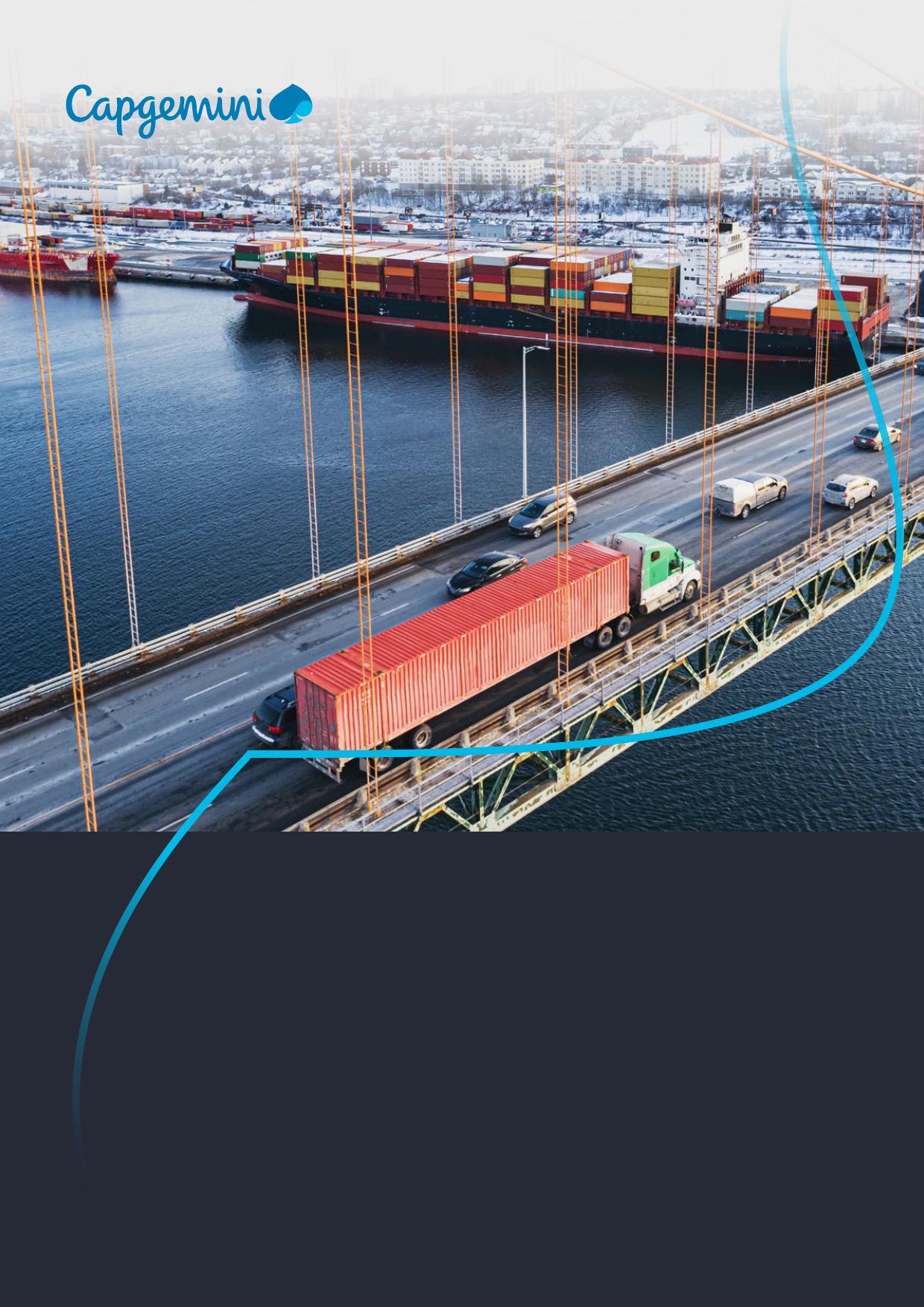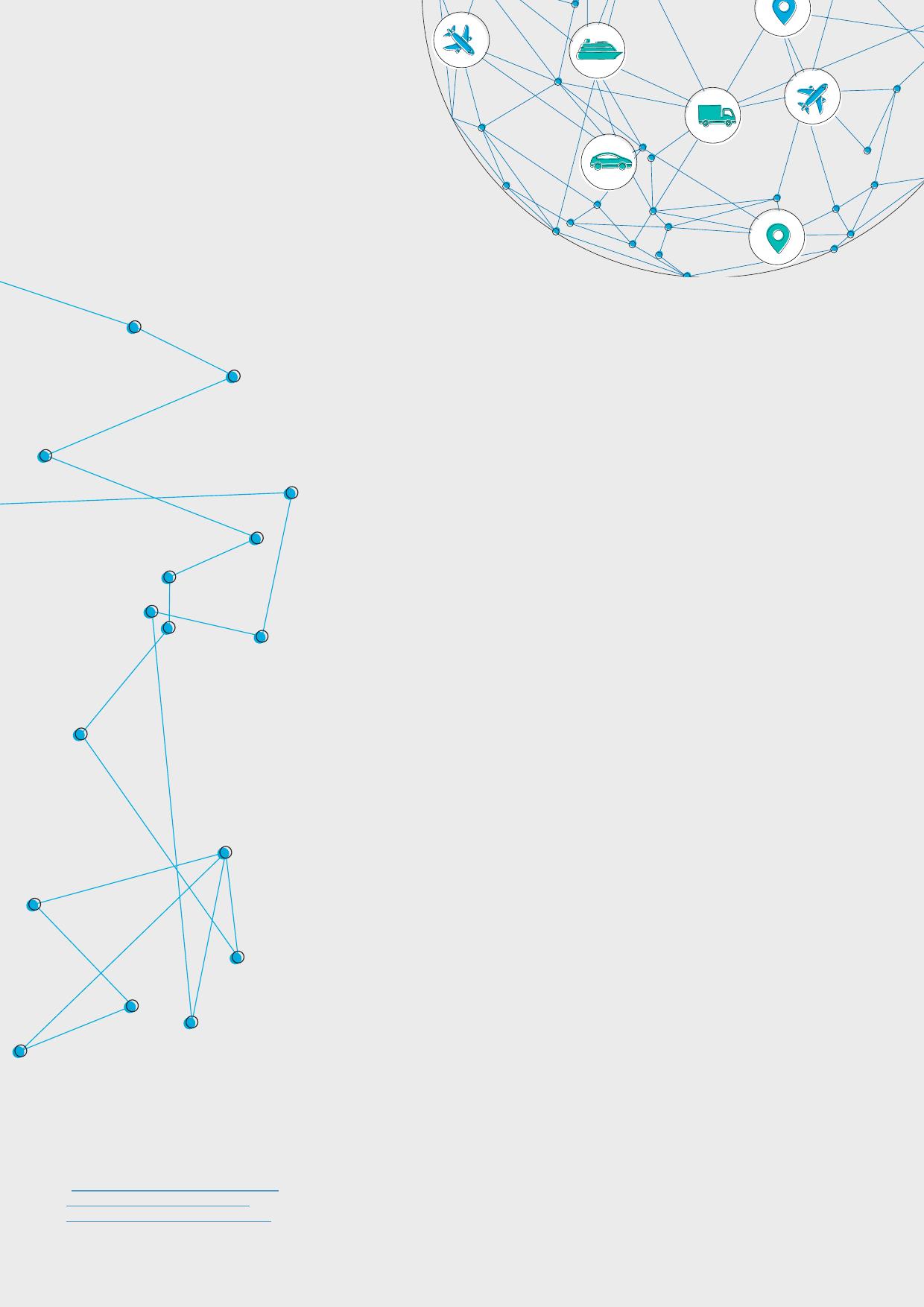Forresilience,intelligence,connectedness,andsustainabilityTRANSFORMINGTHEAUTOMOTIVEINDUSTRYSUPPLYCHAIN2TRANSFORMINGTHEAUTOMOTIVEINDUSTRYSUPPLYCHAINEXECUTIVESUMMARYAutomotiveindustrysupplychaindisruptionrevealsitsstrategicroleandtheneedforchangeRecentdisruptionstotheautomotiveindustryanditsenvironmentarenowleadingtofar-reachingchangesthroughoutthesupplychain,aswellastoabetterappreciationofitsstrategicimportance.Relevantdisruptionsinclude:•Politicalandeconomiceventsduringandafterthepandemic.Theseareforcingcompaniestoundertakerapidsupplychainevolutiontoincreaseflexibilityandoptimizeriskmanagement.•Rapidregulatorychange.AlackofvisibilityinthesupplychaincanhampercompliancewithemergingESGlawsandguidelines.•Newcustomerexpectationsthataddfurthercomplexity.Forexample,customersnowexpectanomnichannelpurchasingexperience–makingnewdemandsonoutboundlogistics–and,oncethey’reusingthecar,wanttobuynewfeaturesasaservice.•Far-reachingchangestotheautomotivebusinessitself,suchasnewentrantsandbusinessmodels.SuccesswithEVsandsoftware-definedvehicles,forexample,dependsonformingtherightsupplierrelationships.Thesedisruptorshaveledautomotivecompaniestoreappraisetheirwholeapproachtothesupplychain,withabetterappreciationofitsstrategicrole.Theyknowthatasmalleventsomewhereinthesupplychaincanhaveabigimpactonbusinessgrowthandcontinuity,andthattherightcapabilitiesinthisareacanthereforeconferastrategiccompetitiveadvantage.However,mostautomotivecompaniestodayfeelthattheyarenotyetfullyequippedtoseizethisadvantage.Fewerthan20%oforganizationsacrossallindustriescurrentlyconsiderthemselvesabletohandletoday’ssupplychainchallengeswithconsistentsuccess1,andourexperiencesuggeststhatautomotivecompaniesfitthispattern.TransformingtheautomotivesupplychainTodealeffectivelywithdisruptionsandchallenges,anautomotiveorganizationneedstoincreasetheresilienceandadaptivenessofitssupplychain.Bydoingso,thebusinesswillensurethatitcantacklebothcurrentpressuresandfuture“blackswan”disruptions,safeguardingitslong-termprospects.Resiliencedepends,fundamentally,onusingdatatoobtainvisibilityandintelligencerightacrossthesupplychain.Inordertobeabletocorrectlyidentifyrisksandbuildtrustamongtheorganizationsinthedownstreamvaluechain,visibilitymustnowextendtotheNthtierofthesupplierecosystem.Inaddition,OEMsarerealizingthattheyneedtobroadentheirsupplychainapproachtoprovideresilience,intelligence,connectedness,andsustainabilityacrosseveryaspectoftheend-to-endsupplychain,fromprocurementtopackagingmanagement.1CapgeminiResearchInstitute,2022,“Howgreaterintelligencecouldsuperchargesupplychains,”page14EVOLUTIONORCHESTRATIONDATATECHNOLOGYTALENTFigure1:FiveleverstotransformthesupplychainRESILIENTCONNECTEDINTELLIGENTSUSTAINABLELEVERSFORCHANGEOUTCOME–ASUPPLYCHAINTHATIS:3TRANSFORMINGTHEAUTOMOTIVEINDUSTRYSUPPLYCHAINItalsomakessensetoimproveunderstandingofdemandwithacombinationofdemandsensingandinputsfromvarioussourcesofdemandinformation.Betterintelligenceaboutdemandenablesamoresophisticatedapproachtoplanning.EnablersofsupplychainresilienceAutomotivecompanieshaveseveralleversthattheycanpulltoincreasevisibilityandresilienceinthesupplychain.Forexample:Inanongoingevolutionofthesupplierecosystem,leadingcompaniesarealreadyconsideringwhethertheyshouldbecollaboratingdirectlywithsuppliersondownstreamtiers,especiallysemiconductorproviders(orevensettinguptheirownrefineriesforlithium).Theyarealsoreevaluatingthenumberofsupplierstheyneedineacharea.Somearealsomovingtocloserrelationshipswithasmallernumberofsuppliersinstrategicareas.Orchestrationofthesupplychainisatopenablerofresilience.Itrequiresacentralgovernancestructurefortheindustry,withrules,standards,andguidelinestobeagreedfirstregionallyandthenacrossthewholeindustry.Thesewillalsoapplytoplayersfromotherindustriessuchastextilesthatparticipateintheautomotivesupplychain.Dataiskeytoprovidingvisibilityandhenceachievingresilience.Withtoday’stechnology,anextralayerofsoftwarecaneasilybeintroducedtoaddintelligencetotheorganizationthroughdata-enableddecision-making.Aswellasimplementingtheseapproaches,companiesalsoneedtoensurethattheyhavetherightmindsettoadoptthemrightacrosstheorganization,whichmayrequireaculturalchange.Technology–drawingonandcombiningbothengineeringandITdisciplines–isrelevanttomanyaspectsofthistransformation.Thecombinationoftechnologicalinnovationandwell-manageddatacanenableplanningandmodelingofunprecedentedsophistication,andcanprovideundreamed-oflevelsofvisibility.Someofthemostexcitingtoolsrequireintegrationofoffersfromnewerproviderssuchashyperscalersandspecialistdatasciencesolutionvendors.Talenthasalwaysbeenattheheartofaneffectivesupplychain.Theskillsetnowrequiredisdifferent,though,withadvanceddatascienceanddecisionsupportskillsbecomingessential.Skillsgapscanbeaddressedthroughtheusualmethodsofupskillingandrecruitment,butimaginativenewapproachesarealsolikelytobeneededinthishighlycompetitivearea.RecommendationsforincreasingresiliencenowCompaniesknowtheyneedtouptheirgameinareasthatstronglyinfluenceresilience.Stepsthatautomakerscantakenowincludethefollowing.Rethinkplanning.Adoptingadvancedapproachessuchascomplexscenarioplanningmakesitpossibletoforecastdemandfarmoreaccurately,withintegratedbusinessplanningtorespondtochange,andtocontinuouslyupdatesupplierssothattheycanadjusttheirownplans.Embracetransparentcollaboration.Considerwhetherclosersupplierpartnershipscouldincreaseresilience.Strengthenconnectionsbypromotingdatasharingandmutualtrust.Gethelpwithinnovation.Therightecosystemofexpertadvisorsontechnologyandengineeringcanhelpthecompanymoveforwardattherightpaceandwiththerightsolutions.Buildadata-drivenculture.Thiswillensurethatnewsolutionsaretrustedbythebusiness,andthattheinsightstheygenerateareusedtodrivedecisionsandactions.Thisapproachwillhelpautomotivecompaniestobuildaresilient,connected,intelligent,andsustainablesupplychain:onethatwillbearichsourceofcompetitiveadvantage.4TRANSFORMINGTHEAUTOMOTIVEINDUSTRYSUPPLYCHAININTRODUCTION:Theneedforsupplychainresilience5SETTINGTHESCENE:Supplychainchallengesintheautomotiveindustry6LEVER1:Evolution12LEVER2:Orchestration14LEVER3:Data16LEVER4:Technology18LEVER5:Talent22THEFUTUREOFTHEAUTOMOTIVESUPPLYCHAIN:Recommendations23TABLEOFCONTENTS5TRANSFORMINGTHEAUTOMOTIVEINDUSTRYSUPPLYCHAININTRODUCTION:THENEEDFORSUPPLYCHAINRESILIENCECurrentresiliencelevelsfallshortofautomotiveindustryneedsFewerthan20%oforganizationscurrentlyconsiderthemselvesabletohandletoday’ssupplychainchallengeswithconsistentsuccess2.Thatfindingisparticularlyworrisomefortheautomotiveindustry.Recentdisruptionshaveemphasizedthestrategicimportancetothebusinessofsuppliers–notjustinTier1butatalllevels–aswellasofsupportpartnerssuchasthird-partylogisticscompanies(3PLs).Optimizingthesupplierecosystem,andthewayitismanaged,isclearlycriticaltoacompany’soverallresilience.Leadingautomotivecompaniesrealizethatthereisagaptobefilledhere.Already,theyaresystematicallyinvestinginsuppliersatalllevels,includinginsuppliersofrawmaterialsforbatteriesandmicrochips.ThiscontrastswiththehistoricalpositionwheretheirinvestmenttendedtofocusonTier1suppliers.OrganizationsarealreadyrecognizingthestrategicnatureofthesupplychainMajorOEMsarenowrecognizingthatexcellentsupplychainmanagementcanprovidethemwithasignificantcompetitiveadvantage,andarethereforeturningitintoastrategicfunctionwithitsownbudgetandboard-levelmanagement.ThosesupplychainCXOsareexertingincreasinginfluenceoverautomotiveorganizationsandemergingasfutureCEOs.Regulatoryandpolicychangesglobally,especiallyintheareaofsustainability,areacceleratingthisshift.TheautomotivesupplychainnowneedsradicaltransformationProgressisalreadybeingmade,butautomakersknowthatmorerevolutionarychangeisneeded.Ithasbecomeclearthatminordisruptionsanywhereinthesupplychaincandisastrouslyaffectbusinessgrowthandcontinuity.Inaddition,changestothebusinessenvironmentarealteringwhatisneededfromthesupplychain.Companiesarethereforestartingtorethinkthewholesupplychainmodel.Theyarebreakingnewgroundhere,though.It’sclearwhatisneeded–asupplychainthathasend-to-endresilience,andisalsoconnected(i.e.there’sgreatinternalandexternalreal-timeinteractionandcommunication),intelligent(i.e.decisionsatalllevelsaredrivenbyup-to-dateinsights),andsustainable(i.e.abletomeettheorganization’sESGcommitmentsandtheexpectationsofexternalstakeholdersinthisarea).Butit’snotsocleartocompanieshowallthatcanbeachievedwithintherighttimescale.AdeepdiveintotheautomotivesupplychainThisreportexplainssomeofourcurrentthinkingonhowtheautomotivesupplychainmustevolvetorealizethepotentialstrategicadvantagethatleadershipinthisareacanbring.Whileourfocusisonpassengercars,muchofthisthinkingisequallyrelevanttocommercialvehicles.2CapgeminiResearchInstitute,2022,“Howgreaterintelligencecouldsuperchargesupplychains,”page146TRANSFORMINGTHEAUTOMOTIVEINDUSTRYSUPPLYCHAINSETTINGTHESCENE:SUPPLYCHAINCHALLENGESINTHEAUTOMOTIVEINDUSTRYUnderstandingtheimperativeforchangeThesupplychainhasalwaysbeenahighpriorityfortheindustry,butit’sonlynowthatitsstrategicroleisfullybeingrealized.Thisrealizationhasbeenenhancedbyrecentsupplychainchallenges,whichinturnhaveemergedfromseveraldisruptivefactors.Thesedisruptionspredominantlyfitunderfourheadings:politicalandeconomicevents;rapidregulatorychange;newcustomerexpectationsandtheireffectonoutboundlogistics;andchangestotheautomotivebusinessitself.Figure2:DisruptionsNEEDFORARESILIENTSUPPLYCHAINPOLITICALANDECONOMICEVENTSRAPIDREGULATORYCHANGECHANGESTOTHEAUTOMOTIVEBUSINESSNEWCUSTOMEREXPECTATIONSAFFECTINGOUTBOUNDLOGISTICS7TRANSFORMINGTHEAUTOMOTIVEINDUSTRYSUPPLYCHAINDISRUPTION1:PoliticalandeconomiceventsRecenteventssuchasthepandemicandthesituationinEasternEuropehaveshownjusthowindispensablethesupplychainistoanautomaker.Theimpactontheindustryofchipshortages,forexample,isstillbeingfeltandwillnotquicklybeforgotteninviewofthelostsalesthatresulted.Moregenerally,manyregionsareseeingunprecedentedpoliticaluncertainties.Coupledwitheconomicinstability,theseareforcingcompaniestorevisittheirsourcingandmanufacturingpoliciesinordertominimizerisk.Asaresult,supplychainsareevolvingfastanddynamically.Evenso,organizationsfaceanexistentialchallengeastheyseektomaintaintheircompetitiveadvantageinahighlyunpredictablebusinessenvironment.Asanexample,organizationshaveinitiatedmineralminingandrefineryinvestments.DISRUPTION2:RapidregulatorychangeTheregulatoryclimateistightening,withcontrastingapproachesindifferentregions.InEurope,governmentsandbodiessuchastheEuropeanCommissionareworkingintensivelywithNGOsandotherstocreatelawsandregulationstoguidecompaniesastohowtheyshouldruntheirsupplychainsfromtheESGperspective.TheUSisprobablyasdeterminedtotackletheseissuesbut,aswe’lldiscussbelow,istakingadifferentapproach.Otherregionsareatvariousstagesoflegislationandregulationinthisarea.EUrulesandguidelinesaffectingthesupplychaininclude:•TheGeneralSafetyRegulation(GSR)aimingtoreduceroadaccidentsandinjuriesbyfittingsafetytechnologiestonewvehicles.Thisisbeingextendedtoallnewregistrationsin2024,meaningthatitwillhaveagreaterimpactonproductandfeaturedesignandonthepartsecosystem.•TheCorporateSustainabilityReportingDirective(CSRD).•TheEcodesignforSustainableProductsDirective.•TheEuropeanGreenDeal,abaselinefromwhichmanynationalinitiativeshaveevolved.•TheGeneralDataProtectionRegulation(GDPR)–notnewbutstillbringschallenges,forexamplewithrespecttovehicledata.RelevantlegislationandregulationintheUSincludes:•TheCHIPSandScienceActaimingtostimulatelocalmanufacturingofsemiconductors,whichwillaffectsupplierstrategy.•ExecutiveOrder(EO)14028whichisdesignedtoimprovecybersecurity.•InflationReductionActof2022.8TRANSFORMINGTHEAUTOMOTIVEINDUSTRYSUPPLYCHAINDifferentregionsareapproachingregulationindifferentways.TheEuropeanCommissionisaimingtomeetESGobjectivesprimarilythroughregulation.TheUSisemphasizingincentive-basedmodelsthatencouragebusinessestocompeteinputtingforwardthebestideasandsoattractmorecapital.DevelopingnationssuchasIndiaarealsoencouragingadoptionofnewESG-compliantproductsthroughpolicychangesandnewapproachestopolicyimplementation.OEMsandTier1sneedESGsystemsandenforcement-basedapproachesforensuringcompliancetoESGregulations.TheseareessentialtoensuringthatthesupplychainisfullyESG-compliant,sinceESGrequirementsapplytothewholeend-to-endsupplierecosystem.3EuropeanCommission,Brussels,December112019,“COMMUNICATIONFROMTHECOMMISSIONTOTHEEUROPEANPARLIAMENT,THEEUROPEANCOUNCIL,THECOUNCIL,THEEUROPEANECONOMICANDSOCIALCOMMITTEEANDTHECOMMITTEEOFTHEREGIONS:TheEuropeanGreenDeal”4FederalMinistryofLabourandSocialAffairs,SupplyChainAct,webpage,accessedJune1120235FederalOfficeforEconomicAffairsandExportControl,SupplyChainAct:ReportingObligation,webpage,accessedJune112023IndividualregulationsposetheirownchallengesDerivedfromtheEuropeanGreenDeal3,Germany’sSupplyChainDueDiligenceActwasinitiallyapplicabletocompanieswithmorethan3,000employeesbutissoontobeextendedtothosewithmorethan1,0004.Thesecompanieswillhavetoextendtheirscrutinytosuppliersfurtherdownthesupplychain,includingtosupplierswithwhichtheyhavenodirectrelationship.TheActislinkedtoreportingrequirementsfromvariousGermanauthoritiessuchastheFederalOfficeforEconomicAffairsandExportControl(BAFA)5.9TRANSFORMINGTHEAUTOMOTIVEINDUSTRYSUPPLYCHAINDISRUPTION3:NewcustomerexpectationsaffectingoutboundlogisticsCustomerexpectationsaboutthepurchasingexperiencehavechangedrapidlyinthepastthreeyears.Theexpectedexperienceisevolvingfromsimplybuyingvehiclesfromdealerstoomnichannel,witharangeofadditionalfeaturesaroundonlineconfiguration,dealerandagencymodels,andseamlessintegrationofonlineandofflineleadgeneration.Thischangeisalsotransformingrequirementsaroundvehicledeliveryandoutboundlogistics.Automakersthereforeneedtocreate,andoptimize,newandcomplexoutboundlogisticsprocessestosatisfytheexpectationsaroundomnichannelexperience.Thisrequiresadvancedalgorithmsandsophisticateddatamanagementandmodelingtechniquesforoptimizationpurposes.Forecasting,andsalesandoperationsplanning,areinstrumentalforresilience.Pastforecastingmodels,basedonjustafewparameters,arebeingreplacedbylargedata-andanalytics-basedmodels.Furthermore,themeasurementsusedareevolvingfromaforecast-actualapproachtodata-basedend-to-endKPIs.ThedrivefordigitalizationofthesupplychainLeadingOEMsarerealizingthatdigitalizationofthesupplychainisthekeytomeetingchangingcustomerexpectations,whilealsocontrollingcomplexityandcostandincreasingadaptability.Forexample,wheneachindividualcarisdifferent,everyfeature,frombatteryandECUnumberstoconfiguration,istrackedthroughproductionuntilitisshipped.Increasingly,thattrackingneedstohappenafteritisshippedaswell,toprovidecompletetraceability.Thiscanbedonebymaintainingadigitaltwinforeveryvehiclesold,whichmayalsoimproveefficiencyandspeedintheaftermarketsupplychain.10TRANSFORMINGTHEAUTOMOTIVEINDUSTRYSUPPLYCHAINDISRUPTION4:ThechangingnatureoftheautomotivebusinessitselfProductlandscapechanges,suchastheadventofEVsandsoftware-definedvehicles,aremodifyingthecharacterofthesupplychainbyalteringwhatOEMsneedfromtheirsuppliersandthenatureofthecollaboration.Microchipsarebecomingcentralandvehiclestendtouseasmallernumberofmorespecializedchips,implyingcloserrelationshipswithasmallergroupofsuppliersinthisfield.Thesechangesnecessitateend-to-endavailabilityofreal-timedataondemand,supply,andESGparameters.AutomotivesupplychaintransformationisnowparamountBuildingresiliencetorespondtothesedisruptionsrequiresaparadigmshiftinthewholesupplychain.Thereareotherreasonstotransformthesupplychain,too.Forexample,tocopebetterwithmacroeconomicpressuressuchasinflation,OEMsandsuppliersneedtooptimizeinventoryandincreaseresilienceandefficiency.(Inflationisaparticularconcernforsmallsupplierswhomayneedtoborrowmorecashathigherrates.)Thejourneytoresiliencehastwokeyfacets.Thefirstisthedevelopmentofanintelligentdatalayerprovidingvisibility,decisionsupport,andriskidentificationforcomplexscenarios.Thatvisibilitymustextendtoeveryaspectofthecompany’sinterests,andtoeverylevelofthesupplychain,aswellastothedemandsideoftheequation.Thesecondfacetofthejourneyisactingonvisibility.Thesupportlayershouldenablescenarioplanningandresponsivenesstodynamicdecisions,anddisruptions,acrossthesupplychain.Asaresult,thesupplychainwillbefarmoreresilient,oftenabletodealwithdisruptionsbeforetheyevenariseusingthelatestdata-derivedintelligence;connectednesswithinternalandexternalstakeholderswillbecomestraightforwardbecauseeveryonewillhaveasharedviewofwhat’shappening,anditwillalsobecomeeasiertomeetsustainabilityobjectivesbycoordinatingactiontoachieveobjectivesandaddresschallengesalongtheend-to-endsupplychain.AbilitytoaddressSource:CapgeminiResearchInstitute,IntelligentSupplyChainResearch,August–September2022Resiliencetrends-impactandpreparednessAllIndustriesB2BB2C/B2B2C11%11%11%66%64%94%6%9%69%10%75%14%73%82%HighbusinessimpactAnticipateecosystemmembermovingupanddownthevaluechainAnticipateend-marketdistortionsEnableinteroperabilitybetweenstocklocationsDevelophardwareandsoftwareplatformsandthecirculareconomySecurecustomerandsuppliermarketaccessBalancejust-in-caseresiliencewithjust-in-timeefficiencyDeploypandemic-proof,agileplanningandexecution11TRANSFORMINGTHEAUTOMOTIVEINDUSTRYSUPPLYCHAINWhyautomotivesupplychaintransformationissohardTheautomotiveindustryhasoneofthemostcomplexsupplychainsofanysector,notleastbecauseitisinterwovenwithotherindustriessuchaschemicals,ferrousandnon-ferrousmetals,textiles,andsoon.Withsomanydifferentindividualplayersnaturallytryingtosafeguardtheirowninterestsandbusinesses,achievingthetransformationtoaresilientsupplychainisextremelydifficult.Inthenextsectionsofthisreport,weoutlinefiveleversthatcompaniescanpulltoovercomecomplexityandincreaseresilienceinthesupplychain.Figure3:Inallindustries,supplychainperformancefallsshortofrequirements12TRANSFORMINGTHEAUTOMOTIVEINDUSTRYSUPPLYCHAINLEVER1:EVOLUTIONBuildaresilient,connected,intelligent,andsustainablesupplychainintotheorganization’sstrategyIt’softenthe“unknownunknowns”thatreallyhurt.Aswellascopingwithtoday’spressures,businessesmustpreparetodealwithfuture“blackswan”disruptions.Organizationsshouldbeabletoleveragedataandintelligencetoanticipaterisks,andrespondtodisruptionsinanagilemannerbychoosingfromarangeofalternativeplanstosuiteachscenario.Inthisway,andwiththerightlogisticsapproach,itwillbepossibletolimitlossesfromunforeseenevents,andtosafeguardthefutureofthebusiness.Supplychainresilienceisanessentialpartofpreparednessfortoday’sunpredictablebusinessenvironment.Inthepost-pandemicera,levelsofbusinessintheautomotiveindustrymaywellreturntopre-pandemiclevels,butwithnewchallengesandthelikelihoodofsimilarsupplydisruptions.Thereforeachievingresiliencedependsonmakingtheorganization,includingitssupplychain,asagileandadaptableaspossible,ratherthansimplyreshapingitforcurrentconditions–whichwouldonlybeashort-termsolution.Achievingresiliencerequiresactioninseveralareas,includingorchestration,data,technology,andtalent–allofwhicharecoveredlaterinthisreport.Companiesneedtoaddressalloftheseinparallel,sincetheyareinterdependent.Automakersshouldrecognizethatthesupplychaincanbringstrategiccompetitiveadvantage,andinvestaccordingly.Itnolongermakessensetoregardthesupplychainasapurelyoperationalaspect.Itshouldbetreatedaspartofthebusiness’sgameplan:afunctioninitsownrightwhichmustbeequippedtosucceedandabletoinfluencetheoveralldirection.Nowondersomanyorganizationsarealreadytacklingsupplychainissuesatboardlevel.LookfurtheralongthesupplychainAlthoughOEMstendtofocusontheirrelationshipswithTier1suppliers,resiliencerequiresawiderfocusbecausesmallspecialistcompaniescanalsoplayacriticalpartinthesupplychain.Thesesmallandmediumenterprisesneedtobemanagedinadifferentwayfromlargersuppliers–forexample,processesmayneedtobesomewhatsimplifiedwithoutlossofrigor.It’simportanttooverseetheentiresupplychainandnotjusttheoneortwonearesttiers.InthepastOEMshadextendedvisibilityincertainareas,suchasmining,wherepublicconcernaboutproductionmethodsforcedadeeperdive.Now,companiesneedtoachievevisibilityofthewholesupplychainsothattheycanbeclearwhereproblemsareandjointlyworkonsolutions.Tocomplywithantitrustlegislation,thiscanbedonewithoutnecessarilyidentifyingthecompaniesconcerned.13TRANSFORMINGTHEAUTOMOTIVEINDUSTRYSUPPLYCHAINManufacturingKPIsandparameterssuchascostandqualityarealreadybeingextendedbeyondtheirtraditionalscopeoftheOEMandTier1toprovidevisibilityofTiers2and3.However,it’snowvitaltoextendvisibilitybeyondTier3inordertobeabletocorrectlyidentifyrisksandbuildtrustamongtheorganizationsinthedownstreamvaluechain.MakesupplierrelationshipsmorecollaborativeAmorecollaborativeapproachtothesupplychain,withcustomersandsuppliersdevelopingproductsandsolvingproblemsjointlyforawin-win,mightbemoreconducivetoresiliencethanonewheresuppliersareexpectedtodelivertoacontractandsolveproblemswithoutbotheringthecustomer.Asaminimum,companiesshouldconsideramovetowardmorestrategicsourcing–whereeachOEMhascloserrelationshipswithasmallernumberofsuppliers.TherearesignsthatthismayalreadybestartingtohappeninEuropealthoughtheshiftishardtomeasure.Forexample,becauseofthecriticalityofelectronicsandmicroprocessorsinsoftware-definedvehicles–andinthelightoftheshortagesthatemergedduringthepandemic–OEMsareforgingdirectstrategicconnectionswithchipsupplierswhotheypreviouslywouldhavedealtwithviaTier1s.TheOEMshopethatthiswillenhancetheirabilitytoreactswiftlytochangesindemand.(AlternativepossibilitieshereincludethatofanOEMcreatingtheirownproductionfacilitiesforrawmaterials–forexample,lithiumrefineries.)Tightercollaborationalsodependsonhighlevelsoftrustbetweentheparties,alongwithindustry-standardapproachestomeasuringandcommunicatingkeyparameters(whichCatena-Xistryingtoachieve6).DesignproductsandplantswithsupplychainresilienceinmindSoftwareistakingoversomeofthefunctionalityofhardware(includingchips)insoftware-definedvehicles.Theplatformapproach,wherevehiclesacrossarangealluseidenticalhardwarethatiscustomizedusingsoftware,isthelogicalconclusionofthistrend.This,alongwiththecloserstrategictiesbetweenchipmanufacturersandOEMs,shouldhelptosimplifysupplychains,andthereforeincreaseresilience.ThissimplificationcouldbeacceleratedbythefactthatOEMsarealsoworkingtoreducethenumberofdifferentchipsneededineachvehicle.Plantscanbedesignedsothattheycanswitchfromoneproducttoanothertorespondtochangesindemand.Forexample,oneOEMhasanassemblylinethatcanswitchfromconventionalvehiclestoEVsandback.Especiallyifthesuppliersareequallyflexible,thiscanbeavaluablecontributortoresilience.Tier1Tier1Tier1Tier1Tier1Car/truckOEM4Car/truckOEM3Car/truckOEM2Car/truckOEM1NewnormTraditionalMines/rawmaterialsprovidersNthtierDealersandOmnichannelRefineryverticalintegratione.g.lithium/raremetalrefinery/semiconductorsTier1Tier2Tier2Tier2Tier2Tier2Tier2Tier2Tier2Tier2Tier2Tier2Tier3Tier3Tier3Tier3Tier3Tier3Tier3Tier3Tier3Tier3Tier3Software&engineeringserviceproviders/logisticspartners/insurance/aftermarket/maintenanceserviceetcInformationflowMaterialflowDecisionlayerwithtransparentdata&real-timeinsightsAgile&real-timescenarioplanningandmaterialsupply/demandupgradesFigure4:Verticalintegrationforsupplychainresilience6Catena-X,StandardsintheCatena-Xdataecosystem,webpage,accessedJune11202314TRANSFORMINGTHEAUTOMOTIVEINDUSTRYSUPPLYCHAINLEVER2:ORCHESTRATIONAcentralgovernancestructurefortheindustry–andbeyond–isessentialfortheorchestrationofaresilientsupplychainIfeveryoneisplayingtheirowntune–withdifferentwaysofmanagingandusingdata,forexample–therecanbenoharmonyandthereforenoresilience.Beforeresiliencecanbeachieved,itisnecessarytoagreeaframeworkofsharedrules,standards,andguidelines,firstregionallyandthenacrossthewholeindustry.Theseguidelinesalsoneedtobedesignedtoapplytoplayersfromotherindustrieswhoparticipateintheindustry’scomplexsupplychain.Suchrules,standards,andguidelinesdonotexistyet,butorganizationssuchasCatena-Xaretakingthefirststepstowardthem.Figure5:OrchestrationcanproduceharmonyandhenceresilienceRULESECOSYSTEMFRAMEWORKGUIDELINESSTANDARDSSUPPLYCHAINRESILIENCESTRATEGY15TRANSFORMINGTHEAUTOMOTIVEINDUSTRYSUPPLYCHAINIntensivecollaborationisneededtoachievearesilientandsustainablesupplychainfasterInadditiontostandards,theremustbecommitmentfromsupplychainparticipantstoworktogether–otherwise,supplychaintransformationwillbetooslow.ThatmeansthatOEMsandsupplierswhonormallycompetewithoneanotherneedtofindwaystoworktogetherwhilerespectingantitrustlaws.OrchestrationopensupthepossibilityofaconnectedsupplychainOnceallstakeholderswithinthesupplychainarecollaboratingaroundsharedrules,standards,andguidelineswithinastandardgovernancestructure,communication–bothinternalandexternal–becomesordersofmagnitudemoreeffectiveandtheend-to-endsupplychainisabletorespondinanagilemannertochange.16TRANSFORMINGTHEAUTOMOTIVEINDUSTRYSUPPLYCHAINLEVER3:DATASupplychainobjectivesmostlydependontheabilitytoleveragedataWhateverquestionweaskaboutthesupplychain,theansweralwaysseemstobebetterdataexploitationtoprovideintelligenceanddecisionsupport.Theabilitytocollectandmanagedata,andtoderiveinsightsfromit,isthe#1enablerforresilienceandsustainabilityinthesupplychain,aswellasothergoals.Automakersknowthatmakingfulluseofdatatocreatevisibilityofthesupplychainwouldhelpthemtoensureanddemonstrateregulatorycompliance;createbetter,earlierforecaststhatcanbeusedtoplanproductionandinformsuppliers,makingthesupplychainmoreresilientandstable;andbuildrelationshipsoftrustwithsuppliers,customers,regulators,andotherstakeholders.Thisvisibilitypavesthewayforusingdataandanalyticstopredictandpreemptrisk,enablingcomplex,resilientbehaviorbytheOEM,supplier,anddealerecosystem.Butdoingsoisnotalwaysstraightforward,giventhevolumeandcomplexityofdatawithwhichtheyaredealingandthebarriersthatexisttodatasharing,bothinternallyandexternally.SiloedthinkingisachallengefordatamanagementandgovernanceSilosarestillprevalentintheautomotiveindustryandinhibitthesharingofdataandhenceitssuccessfuluseincontextslikeprocurementandin-andoutboundlogistics.Closercollaborationalongthesupplychaindependsondatasharing–butwillingnesstosharedataalsodependstosomeextentontheclosenessofcollaboration,sothisisadifficultconundrumtoresolve.Evenwithinindividualcompanies,dataisnotsharedasfreelyasitshouldbe.Ifprocurementdoesnotfullyunderstandqualityordeliveryissues,itcannotengageeffectivelywithsuppliers.IndustryinitiativeslooksettoimprovedatasharingDatamarketplaces,togetherwithinitiativeslikeCatena-X,shouldalleviatetheproblemofsilosandpavethewayformorecollaborationarounddata.Byhelpingtocreatevisibility,suchinitiativesshouldalsobridgeanytrustdeficitbetweenpartiesinthesupplychain.Region-specificregulatoryguidelinesaroundESGcanalsoplayapivotalroleinenhancingthisdata-sharingcultureacrosstheend-to-endsupplychain.AutomakersneedtoactoninternaldatasharingtooInternally,companiesmustpromoteacollaborative,data-drivenculturewherefunctionssuchasprocurement,R&D,andqualitymaintainacontinuousdialogue.Thiswillbuildafullpictureofwhatcustomersreallywantandneed.Seniormanagementcanleadthischangebymovingawayfromsilo-specificKPIsandfindingwaystoincentivizeeveryonetoseethebiggerpictureoforganization-widetargetssuchasnetzero,andworktowardthem.Inadditiontotheculturalchange,successheredependsonimplementinganeffectivedataplatformtogetherwithstronggovernanceanddatamanagement,toensurethatdataisshareableandreliable.Industryinitiativestostandardizedataformats,whileprimarilyaimedatfacilitatingsharingacrosscompanyboundaries,mayalsostreamlinedatasharingbetweeninternalfunctions.17TRANSFORMINGTHEAUTOMOTIVEINDUSTRYSUPPLYCHAINTechnicalinnovationtotherescueFortunately,itiseasierthaneverbeforetomakethemostofdata.Withtoday’stechnology,anextralayerofanalytics-andintelligence-drivensoftwarecaneasilybeintroducedtosupportdata-enableddecision-makingforcomplexscenarios.Pullingthenecessarydatatogetherfromdisparatesystemsandplatforms(suchasaninternalERPsystemandahyperscaler’scloudplatform)canbecomplex,butthesenewapproachesandtoolsmakeiteasier.Forexample,itisnowpossibletobuildadata“mesh”thatcombinesdatafrommultipleseparatedatalakesforanalyticpurposeswithoutchangingtheexistingdatastructures.Thisdecentralizedapproachisfarlessdisruptive,time-consuming,andexpensivethanreorganizingtheunderlyingdatatobringitphysicallytogether.ThisapproachdeliversinsightsthataremuchmorepowerfulthanthoseavailablefromindividualsolutionssuchasanERPsystembecausetheycanpotentiallydrawonalltheorganization’sdataplatformsglobally,andeventhoseofitssuppliers.SourcealigneddomainConsumeraligneddomainAggregatedComposedDataproductConsumeraligneddomainSourcealigneddomainFigure6:DatameshTheresultisincreasedtransparencyforconsumers,regulators,andotherstakeholders.Forexample,itbecomesmucheasiertoputtogetherapictureofwhereavehicle’scomponentsarecomingfrom,togetherwiththerelevantcarbonemissionsandoverallfootprint.Usingdatasciencetoshiftthebusinesstoaforward-lookingfocusCurrentKPI-drivenapproachesencourageOEMstolookbackatthepast,butmoderndatascience(includingAIandNLP,forexample)makesitrealistictopredictthefutureusingtechniquessuchasdata-enableddemandanalysis,scenarioplanning,andriskassessment.Thisshiftwillbeagame-changerbecauseitwillmakeitpossibletoplanconfidentlyandtoalignthesupplychaintotheplans,increasingresilience.Automakersshouldlookforshortcutstovisibility:techniquesthatcanfacilitatedatasharingwithoutlarge-scalereorganizationofthedata.Fornewerdataengineeringconceptslikethedatamesh,itmaybenecessarytopartnerwithaprofessionaladvisorwhoalreadyhasexperienceofthisapproach.TheimportanceofidentifyingtherealdatarequirementsWhenimplementingdatameshesandothernewapproaches,it’svitaltobedrivenbythebusinesscaseandtheusecases,inordertomaintainafocusonthedatathatisactuallyneededtocreateinsight.Thisavoidstheoverheadofmanagingunnecessarilylargedatasets.Forexample,withtheperiodicevaluationofsuppliers,datasetstendtogrowasnewparametersareadded–typically,newmeasurementsaroundESGwilltaketheirplacealongsidetraditionalonesrelatingtocostanddeliverytimes.However,decisionsupporttoolsworkbetteriftheyarepresentedwithonlythedatathatenablesaparticulardecision,ratherthanallofthedata.Therefore,thereshouldbemechanismsforselectingthatdataandsettingasidetherest.18TRANSFORMINGTHEAUTOMOTIVEINDUSTRYSUPPLYCHAINLEVER4:TECHNOLOGYEngineeringandITarekeytosupplychaintransformationWhatbrand-newpossibilitiesdoinnovationsinITandengineeringopenupforthesupplychain?Speedingupexistingprocessesbyordersofmagnitudeisjustthestart.Oneofthemostimportantbreakthroughsisthatcurrentanalytics,appliedtowell-manageddata,canenablefullyinformeddecision-makingatalllevels,makingtheorganizationmoreresponsivetochange.Someofthemosttransformativetechnologyoptionscomefromnewerproviderssuchashyperscalersandspecialistdatasciencesolutionvendors,somarketknowledgeisimportant.However,breakthroughscanalsobeachievedthroughingenioususeofexistingtools.Belowwetakeadeepdiveintoautomotivesupplychainimprovementviatechnologyinthreesampleareas:radicalnewapproachestoplanning,increasingsupplychainvisibility,andoptimizingoutboundlogistics.19TRANSFORMINGTHEAUTOMOTIVEINDUSTRYSUPPLYCHAINEXAMPLE1:Rethinkingplanning-anewparadigmBetterforecastsandintegratedplanninghelpsuppliersandbuildtrustInthepast,suppliershaveoftenreceivedforecastsfromOEMsthatwereinaccurate,sometimesbyafactorof100%.Whethertheseinaccuracieswereintentional(perhapsasapowermaneuver)oraccidental,sometrusthasbeenlostandsuppliersoftendon’tfollowforecastsevenwhentheyareaccurate.Abetterapproachtoplanningisneeded,bothtorebuildtrustandbecauseitmakesthesupplychainmoreresilientandsustainableforthereasonsgivenearlierinthisdocument.Technologycanassistwithplanninginmanyways.Forexample,demandsensingviasocialmediacanbecombinedwithmoretraditionaldemandforecastingmethodsbasedondealerinputtoincreaseintelligence.Inaddition,afterrunningtheproductionplan,theOEMcanbegivenmodelingtoolstohelpitinstantlyassesswhichofhalfadozensuppliershastheplantavailable,andischeapest/nearestbearinginmindtheneedfortransportation.Decisionsthathavecausedheadachesinthepast–suchaswhethertohavepartsdeliveredbyairtoalleviateashortage–canbecomestraightforward,becauseallthecostandenvironmentalimplicationscanbeshownonadashboard.TheaimshouldbecontinuousreassessmentandrefinementofscenarioplanningTraditionally,planninghappensperiodically(typicallymonthlyorweekly),andthentheplanchangesonlyinanemergency.Butwiththerightmodelingapproach,it’spossibletoconstantlyreassessyourproductionneeds,realign,andupdatetheinformationyousharewithsuppliers.Thishelpstoreducethedisconnectthatcurrentlyexistsbetweenproduction,sales,andsuppliers,sothatitbecomespossibletogivesuppliersaccurateinformation,offercustomersthemodelsthattheywant,andavoidholdingexcessinventorywithoutcompromisingonresilience.AutomationenablesmoresophisticatedintegratedbusinessplanningWiththerighttools,planningcanbemademuchmoresophisticated.Forexample,itbecomespossibleto:•Createtheplaninteractively,withadvanceinformationandtransparencyintosupplieractivityrightuptotheNthtier.•Satisfymultipleobjectivesandconstraints,usingcomplexscenarioplanningwithacleardefinitionofbusinessobjectives.Inventory,leadtime,transportationtime,costatspecificstages,andESGshouldallbeusedasparametersforevaluationanddecisionswithrespecttodifferentscenarios.•Allowdecision-makingtotakeaccountofadiversesetofvariables.Forexample,thedistancebetweenproductionfacilitiesandmarketsisasignificantfactorincostandcarbonfootprint,andonethatismorecomplexintheEVspacegiventhegeographicalspreadofthesupplychainforbatteryrawmaterials.•Helpdealersimprovetheirownplanning.Providingtoolsandfacilitiestoordermorefrequently–perhapsonceaweekoreveneverytwodaysinsteadofeverymonthortwomonths–wouldalsohelp.Appropriatedataandmodelingtechniquescanhelptooptimizeoutboundlogisticsroutes.20TRANSFORMINGTHEAUTOMOTIVEINDUSTRYSUPPLYCHAINEXAMPLE2:ObtainingsupplychainvisibilityTechnologycanbeusedtocreatevisibilityandintelligencearoundhithertoinvisibleaspectsofthesupplychain.Newautomatedsolutionsareemergingtohelpwithvisibilityandoptimizationinareassuchaspackaging,aswellasthetraditionalfocus,parts.Thesesolutionsprovidemanyinsightsthatcouldneverbeobtainedthroughmanualprocessesorspreadsheets,justbecauseofthehugevolumeandcomplexityofthedata.Thenewsolutionsbreakdownsilos(bothinternalandexternal)andbringdatatogetherfromallovertheworld.Theyprocessitintointelligencethatprovidesareliablebasisforhumandecisions,aswellasautomatingsomedecision-makingprocesses.Forexample,thesesolutionscan:•Providemulti-parametertrack-and-traceforend-to-endlogistics,bothinboundandoutbound.•IncludecrisismanagementplatformstoenableOEMstopredictandanticipatesupplychainproblemssuchasshortagesofparts.•IncorporateAItointerpretsupplychaintrends,makepredictions,andproactivelysuggestriskmitigationbasedondata.21TRANSFORMINGTHEAUTOMOTIVEINDUSTRYSUPPLYCHAINUsecaseexample:extendingsupplychainvisibilitytocoverpackaginguseTomeetsustainabilitygoals,itisimportanttomanagethepackagingusedforpartsmovingalongthesupplychainaseffectivelyasthepartsthemselves.Technologysolutionscanbedevelopedtohelpoptimizeallaspectsofpackaging:notjustpackagingdesignbutalsofillrates,flowarchitecture,logistics,andsoon.Suchasolutionshouldreducetheuseoftransportationandpackagingmaterials(includingplasticsandcardboard)andhencetheoverallcarbonfootprintofthebusinessandofindividualplants.Optimizingthechoiceofpackagingmaterialsusedtotransportparts,andincreasingtheirreuse,candelivervaluablecostsavingsandsustainabilityimprovements.Itbecomespossibletotrackpackaginginasimilarwaytoparts,andtooptimizetheflows.Forexample,anorganizationcaneasilyseewherepackagingelementsarestuckinthesupplychainforseveraldays,sothatdecision-makerscaninvestigateandgetthingsmovingagain.Aswithplanning,complexmodelingisintegraltothistypeofsolution.Data-derivedinsightscanbeusedtodetermine,forexample,whenpackagingshouldbereusedbyweighingupthesavingsagainstthecostandimpactofreturningorotherwiserelocatingapieceofpackaging.EXAMPLE3:ComplexoptimizationofoutboundlogisticsforomnichannelsalesWithcustomersexpectinganomnichannelbuyingexperience,outboundlogisticsprocessesbecomeanorderofmagnitudemorecomplex.Optimizingtheseprocessesrequirescomplexalgorithmsandsophisticatedmodelingtechniques.Whilethealgorithmsandtechniquesexistnow,thecomputationaldemandsmaytaxexistinghardwareplatformstotheirlimits.Quantumtechnologycouldhelpinduecourse,becauseitlookssettoofferunrivaledcomputeprocessingofcomplexcalculationsatscale.OEMsneedtostayawareofdevelopmentsandkeeprefiningtheirexpectationsaboutwhenquantumtechnologywillovertakeclassicalapproachesintermsofperformanceandcost.AlthoughitisprobablytooearlyformostOEMstodomorethanresearchandpilotquantum,itisdefinitelynottooearlytostartdevelopinganadoptionroadmap.Thisway,itwillbepossibletogainacompetitiveadvantagebyactingfastwhendifferentaspectsofquantumtechnologybecomeviableforapplicationslikethis.Figure7:Sixelementstoaddressinimprovingvisibilityoftheend-to-endsupplychainPURCHASING&PROCUREMENTFLOWENGINEERINGSUPPLIERMANAGEMENTPACKAGINGMANAGEMENTORDERMANAGEMENTCRISISMANAGEMENT22TRANSFORMINGTHEAUTOMOTIVEINDUSTRYSUPPLYCHAINAwiderangeofskillsareneededtomakethemostofdataFulluseofdataforsupplychainoptimizationrequiresabroadportfolioofknowledgeandskills,includingstrategy,engineering,technicalandbusinessprocesses,thevaryingregulationsandlegislationthatapplyineachregion,thesupplierecosystem,andtechnologyplatformsandtools.Automakersneedaccesstoalltheseattributes.LEVER5:TALENTSupplychainmanagementrequiresprofessionalskillsSupplychainmanagementisademandingstrategicandtechnicaljobwhoseimportancehassometimesbeenunderestimated.Withcurrentcomplexities,itisimperativethatsupplychainprofessionalshaveknowledgeofdatascience,analytics,scenarioplanning,andfinancialdecision-making.Typically,supplychainmanagementhasbeenpartofmanufacturing,procurement,orevenIT.Now,however,automotiveboardsarerecognizingitssignificance.Theyarestartingtomakeitaroleinitsownright,andtoensureithasbothabudgetandaccesstotheskillsitneedstocarryouttaskssuchasscenarioplanning–whethertheseskillsareinternalorexternal.Investinginsupplychainmanagementtalent–andspecificallythenewskillsetsrequired–willunquestionablysavethebusinessmoneyandallowittoincreaseitsrevenues.Theskillsdonotnecessarilyhavetobeinternal,butmaybefoundbyengagingwithexpertadvisorswhoareatthecuttingedgeofautomotiveindustrysupplychainmanagementandthenewdisciplinesitrequires.SupplychaintransformationskillsarescarceTalenthasalwaysbeenattheheartofaneffectivesupplychain.Theskillsetnowrequiredisdifferent,though.Advanceddatascienceanddecisionsupportskills,togetherwithknowledgeofAI,arelikelytobeneededtoimplementtransformativesolutions:forexample,toreplacetheoldspreadsheetsandmanualprocesseswithradicalnewapproachestotaskssuchasproductionplanning,discussedabove.Aswellasknowledgeoftheavailabletools,companiesneedpeoplewiththeadvancedanalysisskillstoformulatetherequirement.And,ofcourse,alloftheseskillsareinshortsupply.CreativityisneededtofillthetalentgapsSkillsgapscanbeaddressedthroughtheusualmethodsofupskillingandrecruitment,butimaginativenewapproachesarelikelytobeneededinthishighlycompetitivearea.Oneoptioniscollaborationwithexpertadvisors,whichcaninvolveanelementofskillstransfertotheinternalworkforce.Fortechnologyskills,oneoptionisthecreationofadedicatedsubsidiary–perhapsinpartnershipwithatrustedtechcompany–asa“talentmagnet.”23TRANSFORMINGTHEAUTOMOTIVEINDUSTRYSUPPLYCHAINTHEFUTUREOFTHEAUTOMOTIVESUPPLYCHAIN:RECOMMENDATIONSWhatautomakersneedfromtheirsupplychaincanbesummedupwithfourwords:resilience,intelligence,connectedness,andsustainability.Thosefourwordsarequicktosaybutchallengingtoputintopractice.Tohelp,herearefourstepsthatcompaniescantakenowtomovethemtowardthosegoals.1.Rethinkplanning.Ratherthana“oneanddone”approachtoplanningproductionatthestartofeachmonthorweek,createanup-to-dateplanningprocess,basedondataandinsight,thatgivesyouandyoursuppliersthemostaccuratepictureofdemandpossible,andthencontinuouslyrefinesthatpicture.Dynamicscenarioplanningapproachesaredesignedtodojustthat;theymakeitfeasibletoreadjustplansinrealtimetomeetcurrentconditions.Theinformationonwhichplansarebasedshouldincludenotjusttheusualforecastsfromdealers,butalsonewersourcesofintelligencesuchasdemandsensingviasocialmedia.Alsoreevaluateyourplanningtargets:Usedataandmultivariantscenarioplanningtoevaluatemultiplebusinessperformanceparameters–includingtime,cost,inventory,andESGparameters–andenabletherightdecisionstobemade.2.Embracetransparentcollaboration.Considerwhetherclosersupplierpartnershipscouldincreaseresilience.Strengthencriticalconnectionsbypromotingdatasharingandmutualtrust;itcanbeworthparticipatingactivelyinindustryinitiativesdesignedtofacilitatevisibility.Reevaluatethenumberofsuppliersyouhaveineacharea–wouldresiliencebeimprovedbyhavingcloserrelationshipswithjustacoupleofsuppliers?Alsoconsiderwhethertocollaboratedirectlywithsuppliersonlowertiers,suchassemiconductorproviders.3.Gethelpwithinnovation.Therightecosystemofexpertadvisorsontechnologyandengineeringcanhelpyoumoveforwardfastwhentransformingtheautomotivesupplychain.Lookforconsultantsandtechnologyexpertswhocanacceleratethetransformationinarangeofways,fromcreatingorevaluatingsupplychainstrategiestoputtinginplaceactionplansandmanagingculturalchange.Aswellasseekingtheiradviceonbestpractice,askthemtohelpyoucreateyourownecosystemsofspecialisttechnologyproviders,whocanoftenprovideadvanceintelligenceoftechnologybreakthroughs.4.Buildadata-drivenculture.Internalcollaborationisalsocritical,sincesiloscanundermineresilienceandvisibility.Moveawayfromsilo-specificKPIsandinsteadincentivizeeveryonetoseethebiggerpictureoforganization-widetargetssuchasnetzero.Promoteadata-drivenculturewherefunctionssuchasprocurement,R&D,andqualitymaintainacontinuousdialogue.Thiswillbuildafullpictureofwhatcustomersreallywantandneed.Supportculturalchangebyimplementinganeffectivedataplatformtogetherwithstronggovernanceanddatamanagement,toensurethatdataisshareableandreliable.Allthiswillhelptoensurethataccurateinsightsdrivedecisionsandactions.24TRANSFORMINGTHEAUTOMOTIVEINDUSTRYSUPPLYCHAINConclusion:HowtheautomotivesupplychainmustevolveThejourneytoaresilient,connected,intelligent,andsustainablesupplychainrequiresamulti-facetedtransformation,includingtheintroductionofanintelligentdatalayer(integratingtechnologyfromhyperscalersandothers)toprovidevisibility,decisionsupport,andriskidentification.Thistransformationwillfacilitatecomplexscenarioplanningandenablesupplierstorespondeffectivelytodynamicdecisionsacrossthesupplychain.Capgemini’ssupplychaincapabilitiesCapgeminihasdeepexperienceinallaspectsofsupplychainmanagementintheautomotiveindustry,andalsoinotherindustriesthatareatthecuttingedgeofsupplychain.Wehavealsoworkedextensivelywithourautomotiveclientstooptimizetheirdecision-makingtodealwithrecentandcurrentdisruptions.RelevantcapabilitieshereincludeourcombinationofengineeringandITknowledgeandexperience,plusourabilitytointegrateITandOTusingAPIs.Wearethereforeideallyplacedtohelpourclientstransformtheirautomotivesupplychaintorespondtocurrentchallenges,andarealreadyengagedindoingsoglobally.Inaddition,weundertakeextensiveresearchinthisarea.ForexampletheCapgeminiResearchInstituterecentlypublishedareportonHowgreaterintelligencecouldsuperchargesupplychains.AutomotiveindustryknowledgeGlobalreachFamiliaritywithbestpracticeacrossmultipleindustriesIntegratedITandengineeringknowhowCross-culturalchangemanagementskillsfortheglobalenvironment24TRANSFORMINGTHEAUTOMOTIVEINDUSTRYSUPPLYCHAIN25TRANSFORMINGTHEAUTOMOTIVEINDUSTRYSUPPLYCHAINAlexandreAudoinEVPHeadofGlobalAutomotiveIndustryRoshanBatheriSeniorDirector,AutomotiveIndustryLeaderNAOfferLeader–SupplyChainManagement–AutomotiveAUTHORSEXPERTSJacquesBacryEVPDigitalContinuity&ConvergenceGroupOfferLeaderMariamBelasfarSustainableSupplyChainandPackagingEngineeringTeamManager,CapgeminiEngineeringAnuragBharadwajVPHead,AutomotiveIndustryPlatformSvenDahlmeierSeniorDirector,IntelligentSupplyChain,AutomotiveCapgeminiInventMilindDumbreSubjectMatterExpert,SupplyChain,CapgeminiIndiaPascalFeillardSeniorSolutionDirector,CapgeminiEngineeringRuthPetersMarketingDirectorGlobalAutomotiveIndustryMaryemSahnounSustainabilityandSupplyChainExpert,CapgeminiEngineering25TRANSFORMINGTHEAUTOMOTIVEINDUSTRYSUPPLYCHAINAboutCapgeminiCapgeminiisagloballeaderinpartneringwithcompaniestotransformandmanagetheirbusinessbyharnessingthepoweroftechnology.TheGroupisguidedeverydaybyitspurposeofunleashinghumanenergythroughtechnologyforaninclusiveandsustainablefuture.Itisaresponsibleanddiverseorganizationofover360,000teammembersinmorethan50countries.Withitsstrong55-yearheritageanddeepindustryexpertise,Capgeminiistrustedbyitsclientstoaddresstheentirebreadthoftheirbusinessneeds,fromstrategyanddesigntooperations,fueledbythefastevolvingandinnovativeworldofcloud,data,AI,connectivity,software,digitalengineering,andplatforms.TheGroupreported2022globalrevenuesof€22billion.GettheFutureYouWantwww.capgemini.comCopyright©2023Capgemini.Allrightsreserved.



 VIP
VIP VIP
VIP VIP
VIP VIP
VIP VIP
VIP VIP
VIP VIP
VIP VIP
VIP VIP
VIP VIP
VIP